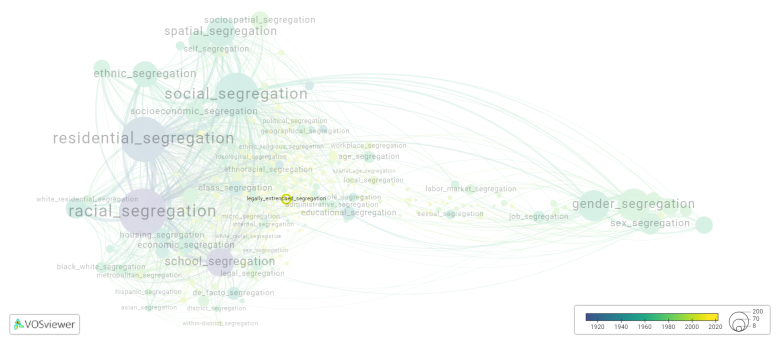Legally entrenched segregation: Difference between revisions
(Creating page) |
(Creating page) |
||
| (9 intermediate revisions by the same user not shown) | |||
| Line 1: | Line 1: | ||
===== Date and country of first publication<ref>Date and country of first publication as informed by the Scopus database (December 2023).</ref>===== | |||
2015<br> | 2015<br> | ||
United | United States | ||
===== Definition ===== | |||
refers to segregation that is officially sanctioned and enforced by laws and government policies. This type of segregation was prevalent in the United States during the period of Jim Crow laws, which mandated the separation of white and black individuals in public spaces, schools, and housing. These laws enforced racial discrimination and maintained white supremacy, creating a system where black individuals were systematically denied opportunities and equal treatment in society. Legally entrenched segregation was abolished by the Civil Rights Act of 1964, which prohibited discrimination based on race, color, religion, sex, or national origin. | Legally entrenched segregation refers to segregation that is officially sanctioned and enforced by laws and government policies. This type of segregation was prevalent in the United States during the period of Jim Crow laws, which mandated the separation of white and black individuals in public spaces, schools, and housing. These laws enforced racial discrimination and maintained white supremacy, creating a system where black individuals were systematically denied opportunities and equal treatment in society. Legally entrenched segregation was abolished by the Civil Rights Act of 1964, which prohibited discrimination based on race, color, religion, sex, or national origin. | ||
==See also== | ==See also== | ||
==Related segregation forms== | |||
Legally entrenched segregation is frequently discussed in the literature with the following segregation forms: | |||
[[racial segregation]] | |||
[[File:legally_entrenched_segregation.png|780x780px]] | |||
This visualization is based on the study [[Segregation_Wiki:About| The Multidisciplinary Landscape of Segregation Research]]. | |||
For the complete network of interrelated segregation forms, please refer to: | |||
* [https://tinyurl.com/2235lkhw First year of publication] | |||
* [https://tinyurl.com/2d8wg5n3 Louvain clusters] | |||
* [https://tinyurl.com/223udk5r Betweenness centrality] | |||
* [https://tinyurl.com/244d8unz Disciplines in which segregation forms first emerged (Scopus database).] | |||
==References== | ==References== | ||
==Notes== | ==Notes== | ||
<references /> | <references /> | ||
== | {{NoteAI}} | ||
==Legally entrenched segregation appears in the following literature== | |||
Flaherty A.B. | Flaherty A.B., Foster C.H. (2015). Gateway to equality: Desegregation and the American Association of University Women in St Louis, Missouri. ''Women's History Review'', ''24''(2), 191-214. Routledge.https://doi.org/10.1080/09612025.2014.945802 | ||
Latest revision as of 07:17, 16 October 2024
Date and country of first publication[1][edit | edit source]
2015
United States
Definition[edit | edit source]
Legally entrenched segregation refers to segregation that is officially sanctioned and enforced by laws and government policies. This type of segregation was prevalent in the United States during the period of Jim Crow laws, which mandated the separation of white and black individuals in public spaces, schools, and housing. These laws enforced racial discrimination and maintained white supremacy, creating a system where black individuals were systematically denied opportunities and equal treatment in society. Legally entrenched segregation was abolished by the Civil Rights Act of 1964, which prohibited discrimination based on race, color, religion, sex, or national origin.
See also[edit | edit source]
Related segregation forms[edit | edit source]
Legally entrenched segregation is frequently discussed in the literature with the following segregation forms:
This visualization is based on the study The Multidisciplinary Landscape of Segregation Research.
For the complete network of interrelated segregation forms, please refer to:
References[edit | edit source]
Notes[edit | edit source]
- ↑ Date and country of first publication as informed by the Scopus database (December 2023).
At its current state, this definition has been generated by a Large Language Model (LLM) so far without review by an independent researcher or a member of the curating team of segregation experts that keep the Segregation Wiki online. While we strive for accuracy, we cannot guarantee its reliability, completeness and timeliness. Please use this content with caution and verify information as needed. Also, feel free to improve on the definition as you see fit, including the use of references and other informational resources. We value your input in enhancing the quality and accuracy of the definitions of segregation forms collectively offered in the Segregation Wiki ©.
Legally entrenched segregation appears in the following literature[edit | edit source]
Flaherty A.B., Foster C.H. (2015). Gateway to equality: Desegregation and the American Association of University Women in St Louis, Missouri. Women's History Review, 24(2), 191-214. Routledge.https://doi.org/10.1080/09612025.2014.945802

